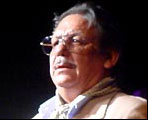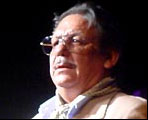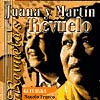(1945-2012)
|
Text & photos: Estela Zatania It’s sad to see so little attention being paid to the passing last Saturday of Martín Giménez, known to the world of flamenco as “Martín Revuelo”. Or perhaps for a younger generation that never had the chance to discover his natural grace and flamenco talent, he was simply “Juana’s husband”. Juana la del Revuelo that is, whom Martín accompanied and supported in all her performances. Martín Revuelo spent years in the noble profession of singing for dance, most notably with the legendary trio Los Bolecos of Matilde Coral and her husband Rafael el Negro with El Farruco. But throat problems forced Revuelo to take on a reduced role. This led to his developing an artistc personality in the grand tradition of the great “festeros”, people specialized in the more festive flamenco forms. Bulerías, tangos and rumbas always with a caustic edge softened by humor and communicated via a thick flamenco voice and an abundance of imagination and originality. His spontaneous on-stage wit became his I.D. With a devilish sense of humor he poked fun at Spain’s newly-established autonomous regions with his “bulerías autonómicas” in which he sang in Galician, Catalonian and Basque, in his own madcap way of course, because he always sang in just one language, that of flamenco. In recent years he used a cane to walk, and in the blink of an eye it would become his imaginary rifle, guitar or umbrella, as the occasion might require and always in compás. Also famous was his rumba about “Doctor Galeno” who was always telling him not to drink or smoke, and every time he opened the refrigerator the lunch meat made fun of him doing palmas…what an exquisitely surreal flamenco sense of humor this man had. Revuelo worked with Manuela Carrasco and Lola Flores among others, and in 1995 had an important part in the film “Bodas de Gloria” with the Farrucos. In the seventies he recorded with Juan Habichuela, and went on to participate in other records, most notably those of his wife, and one of the Tres Mil Viviendas, the Seville neighborhood where he lived. Born in Madrid, with links to Triana by virtue of his marriage, but above all else, flamenco in body and soul. The generation capable of producing this type of artist is slipping away, and with it we are losing a traditional element that gave dimension and meaning to flamenco.
|
Descubre más desde Revista DeFlamenco.com
Suscríbete y recibe las últimas entradas en tu correo electrónico.



























